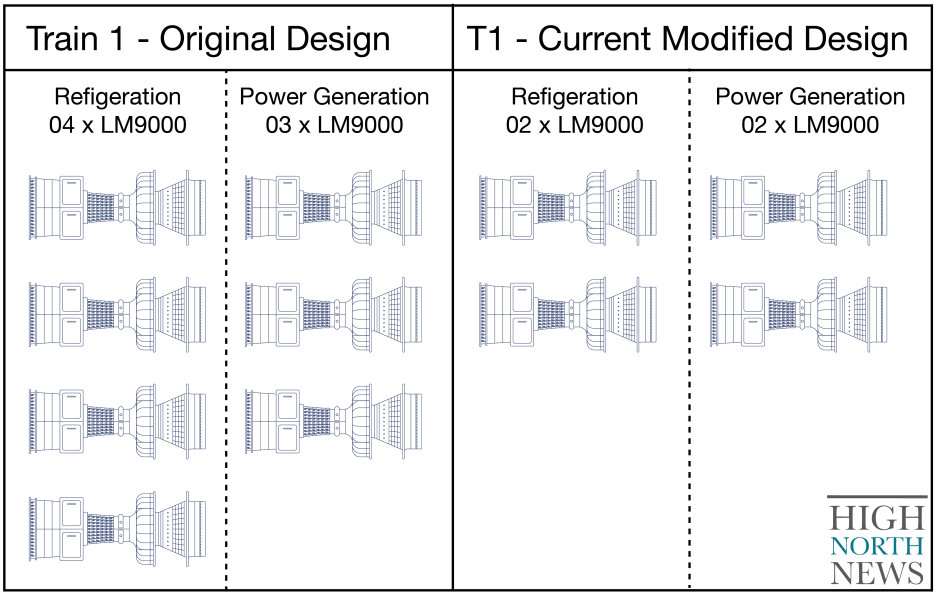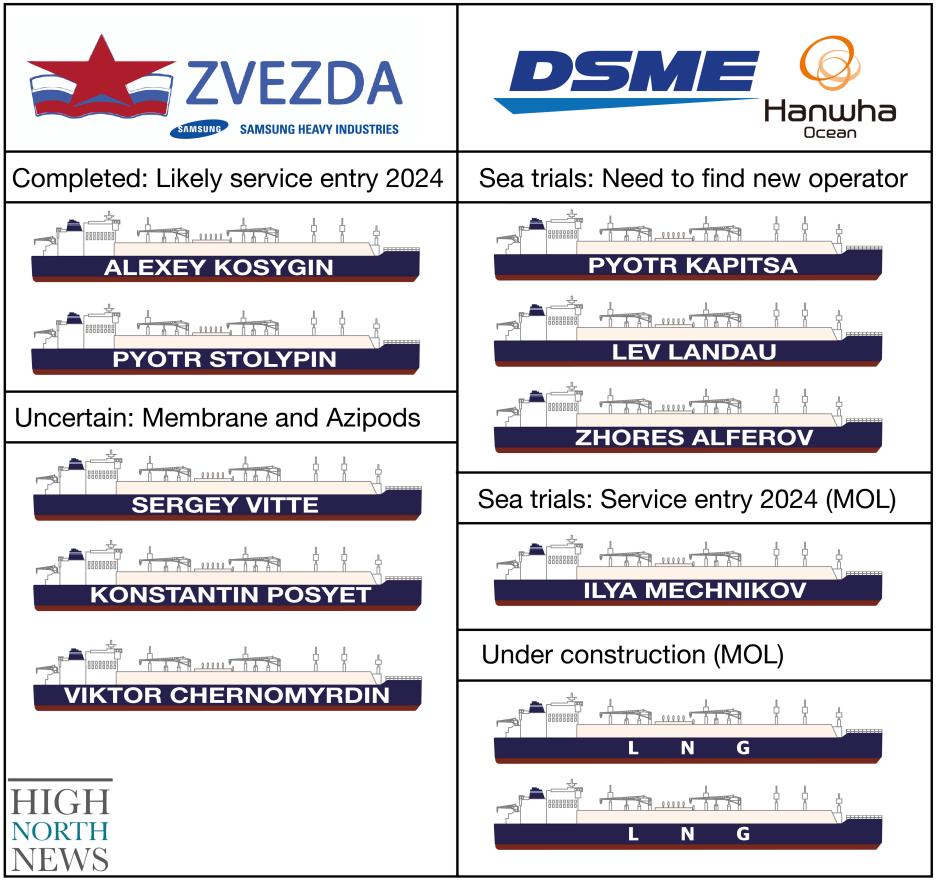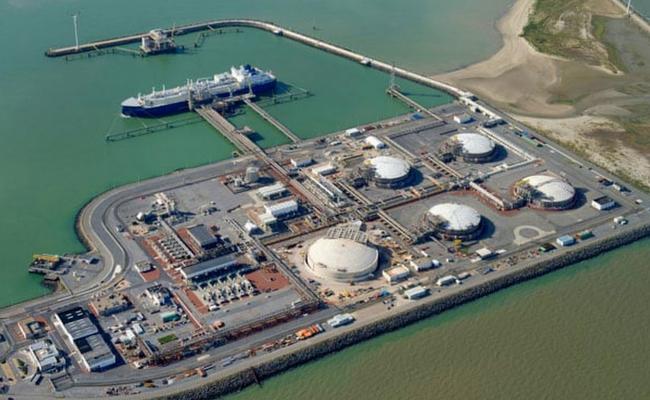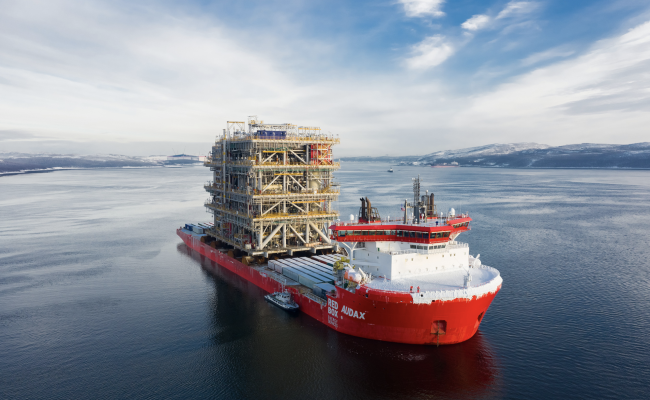Undeterred by Sanctions Novatek Begins Production at Arctic LNG 2

Arctic LNG 2 in its final configuration with all three trains installed. (Source: Courtesy of Novatek)
In spite of mounting international sanctions Russian gas producer Novatek has begun production at Arctic LNG 2 and the first shipment of liquefied natural gas is likely just weeks away. The company managed to successfully redesign its facility to replace Western technology with Chinese imports and a number of Arc7 LNG carriers will enter into service in 2024.
After five years of construction Novatek’s Arctic LNG 2 facility has begun producing liquefied natural gas (LNG) and the first shipments are just weeks away.
Despite the departure of Western companies and a number of rounds of US and EU sanctions, Novatek appears poised to complete all three trains of its Arctic LNG 2 project in the coming two years.
The first production line, or train, assembled on a floating platform near Murmansk and towed to the Utrenny terminal in summer 2023, began liquefaction of natural gas on 21 Dec 2023, confirms Mehdy Touil, a LNG Operations Specialist, who in the past worked as a senior operator for Novatek’s Yamal project.
Touil detailed the technical modifications Novatek undertook to complete the first train in the face of sanctions.
Challenged by sanctions
A key challenge was the lack of LM9000 gas turbines by supplier Baker Hughes. The American company delivered four out of seven turbines before sanctions kicked in.
As a result Novatek was forced to modify the configuration of train 1, while it awaits and installs replacement turbines by Chinese supplier Harbin Guanghan.
Originally train 1 was designed to use seven LM9000s, with three LM9000s for power generation and four more for refrigeration.
All-electric
However, with only four turbines available Novatek reconfigured the first production line to run at lower capacity using two turbines each for power generation and refrigeration. Train 1 began operation with this setup three weeks ago achieving around 50 percent capacity.

Graphic showing the original and current modified design of train 1. (Author’s own work with turbine drawings courtesy of VBR)
Once Novatek receives Harbin Guanghan’s CGT30s turbines it will revert train 1 to its final full capacity configuration: Four LM9000s for refrigeration and five CGT30s for power generation.
Train 2 will not rely on Baker Hughes turbines at all, instead they will be an all-electric configuration. The refrigeration compressors can be driven by turbines as they will be in train 1 or by electric motors in train 2.
No major challenges
“T2 will not be provided with turbines, it will be an all-electric configuration with a pool of CGT30s onshore. T3 is waiting for the operational feedback from the Chinese machinery to decide on the final configuration, but again it should be an all-electric configuration,” details Touil.
The onshore pool of CGT30s could encompass up to 20 units for up to 500 MW for train 2.

Graphic showing the final modified design of train 1 and planned modified design of train 2. (Author’s own work with turbine drawings courtesy of VBR)
Touil does not foresee any additional major challenges for Novatek to complete Train 2 and 3.
“All the Western machinery for T1, 2, and 3 was delivered. I do not see any other impact from the sanctions unless it is on the shipping of the remaining modules from the Chinese yards.”
Rapid progress
A number of remaining modules are currently en route from China to the construction yard outside Murmansk.
While experts, including Touil, expected train 1 to run at 50 percent capacity for most of 2024 until Novatek could install the Chinese turbines, it appears that the company has been able to make rapid progress in integrating the CGT30s.
Touil confirms that “the turbines have been successfully received and installed onshore, serving as a cornerstone for power generation within the project infrastructure for the 1st train.”
A significant source of logistical uncertainties looms large
As a result Novatek may be able to achieve 100 percent capacity for train 1 in the coming weeks and months ahead of schedule. Each train has a nameplate capacity of around 6.6 million tons of LNG per year.
“However, a significant source of logistical uncertainties looms large,” Touil concluded.
How many carriers will be ready?
The limiting factor will likely be the availability of transport capacity, explains Viktor Katona, senior analyst at Kpler, a data and analytics firm for commodity markets.
“The first train might need to run at lower utilization rates so as not to hit tank tops, producing quicker than the LNG carriers can take it off, and the capacity ramp-up would be reflective of tanker availability,” Katona points out.
Western sanctions have slowed down the construction of the second generation of fifteen ice-capable Arc7 LNG carriers vital to Arctic LNG 2’s operation.
Pulled out
At Zvezda, a Russian shipyard in the Far East, a batch of five 2nd generation Arc7 LNG carriers are under construction. The yard may be able to place into service the first two or three vessels in 2024, explains Ben Seligman, a project specialist for Arctic oil and gas development.
As for the Zvezda’s ability to complete the remaining two or three vessels of the initial batch of five ships, questions remain surrounding the readiness of the membrane of the LNG storage system and the azipod propulsion system.
French company GTT and American General Electric, providers of the equipment, pulled out of Russia in 2023.
Chinese help
Zvezda had originally been contracted to complete an additional ten vessels in cooperation with Samsung Heavy Industries (SHI), which provided the main hull blocks for final assembly at the Russian shipyard.
SHI has stopped construction of the hulls, though it has not formally withdrawn from the partnership.
“Zvezda will be looking to China for help here,” explains Seligman.
Carriers from South Korea
A second batch of carriers is being readied at a South Korean shipyard. Here the news is somewhat more positive for Novatek.
Also read (the article continues)
Hanwha Ocean (formerly DSME) had originally been contracted to build six 2nd generation Arc7, three for Russian operator Sovcomflot and three for Japan’s Mitsui OSK Line (MOL).
Western sanctions rendered Sovcomflot unable to provide payment resulting in Hanwha canceling the order. The company, however, completed them at its own expense.

Graphic showing the status of Zvezda and Hanwha Arc7 LNG carriers. (Source: Author’s own work)
“It intends to sell them to another operator. It isunclear how far along Hanwha is in securing the new operator,” Seligman continues.
The three former Sovcomflot vessels have been completed and are currently undergoing sea and gas trials, Seligman confirms. Similarly, the first MOL carrier is conducting sea trials, with the 2nd and 3rd vessel a bit further behind.
“In theory, four of the six are pretty much ready to go. But three of them don't yet have a vessel operator/ owner,” Seligman concludes.
The bigger complication is likely to be the force majeure declaration
Ship-to-Ship transfers remain key
When Novatek begins deliveries from Arctic LNG 2 in the coming weeks, it will likely rely on the ship-to-ship (STS) transfer to optimize the use of its existing fifteen Arc7 carriers from the Yamal LNG project.
Originally it had planned to use its newly deployed floating storage units (FSU) off the coast of Murmansk and southern Kamchatka, but both vessels have been sanctioned by the US since November and have thus far remained unused.
“Given sanctions, it is not clear to me when Novatek might be able to commence operations at the Saam and Koryak FSUs,” emphasizes Seligman.
Novatek has already returned to STS operations for Yamal LNG transferring LNG from Arc7 carriers to conventional carriers off Kildin island. Five such transfers have already taken place in recent weeks.
“I could see Novatek using some of the Yamal LNG Arc7s to shuttle LNG from Arctic LNG 2 train 1 to Kildin for STS transfer to non ice-class LNGCs,” Seligman speculates.
Winter NSR voyages to Asia
Novatek also aims to follow through on its claim of year-round eastbound shipments along the NSR. In 2023 the company announced it would start mid-winter shipments in January 2024. Such experimental winter-time shipments are now in the works.
“These will apparently include one-off shipments in February, March, and April, which has not happened before. These are likely also aimed at allowing Novatek to claim that it has commenced year-round eastbound shipments of LNG to Asia via the Northern Sea Route,” explains Seligman.
Apart from challenges related to transportation, questions arise how the latest round of US sanctions will affect Novatek’s ability to sell its LNG.
Force majeure declarations
Just days after Arctic LNG 2 began production, the project’s minority stakeholders in France, China, and Japan declared force majeure as a result of US sanctions targeting the project.
France’s TotalEnergies, China’s state-owned oil major CNOOC and China National Petroleum Corp (CNPC), and Japan’s Mitsui each hold a 10 percent stake. Novatek controls the remaining 60 percent.
“The bigger complication is likely to be the force majeure declaration, combined with the US sanctions on the project,” explains Jason Feer, global head of business intelligence at Poten & Partners, a global broker for international oil, gas and shipping markets.
Waivers from the US
Novatek’s international partners have offtake agreements for millions of tons of LNG per year based on the size of their minority stakes in the Arctic LNG 2 project.
Also read (article continues)
While Novatek’s equity partners have requested waivers from the US in order to lift those cargoes, there is no guarantee they will succeed. If its partners are unable to secure waivers, Novatek will have to find new buyers, likely on the spot market.
However, as a number of new LNG projects around the world come online in 2024 there may be little appetite for Novatek’s product.
“Chinese imports of LNG in particular have softened over the past year, at the same time new term contracts have kicked in. This means that the Chinese may not need a great deal of additional LNG from Russia,” explains Feer of Poten & Partners.
“It appears that European governments, as well as the US government, are increasingly taking the view that there is enough LNG supply globally, and therefore the Russian volumes are not needed and can be sanctioned without affecting global prices. So then the question will be which countries are willing to violate sanctions on Russia,” asks Feer.
Further impact
Thus far, sanctions have affected the completion of Arctic LNG 2, construction of the 2nd generation of Arc7 vessels, and the use of the two floating storage units (FSU).
Additional rounds of sanctions may further impact Novtek’s ability to secure the needed transport capacity or sell its LNG. The EU has been in talks for much of 2023 to restrict the inflow of Russian LNG into the block.
In contrast to Russian crude oil shipments, where the country has successfully developed a “shadow fleet” of oil tankers, no such opportunity exists for Russian LNG flows.
“For Novatek, it will be difficult to obfuscate the origin of its cargoes and it will be similarly difficult to buy shadow LNG carriers off of the second-hand market because for liquefied gas carriers that market is fairly shallow, if non-existent,” explains Katona, the analyst at Kpler.
Sanctioned cargoes
Jason Feer at Poten & Partners echoes that sentiment.
“First, there are only about 600 or so LNG carriers in the world and I would be surprised if many (or any) of the owners of these vessels are willing to allow them to be used to carry sanctioned cargoes.”
In contrast, the oil market, which encompasses many thousands vessels, is home to owners willing to use their vessels in violation of sanctions. In part because owners know that there will be sufficient trade to keep these vessels employed in the ghost market in the long run.
“LNG carriers are much more expensive and I would be surprised if any owners are willing to risk not being able to return to legitimate trade after being used to violate sanctions,” Feer concludes.
Right now Yamal LNG is the cash cow
Novatek’s Arctic roads to China
It remains to be seen if and to what degree the Western sanction regime can further impact Novatek’s operation at Arctic LNG 2. While the US’ outspoken goal is to “kill the project”, Novatek appears to have the means to see the project through.
Especially as long as it pulls in the profits generated by its neighboring project, Yamal LNG.
“Right now Yamal LNG is the cash cow, and all efforts are spent by Novatek to keep it that way,” explains LNG expert Touil.
EU countries alone send in excess of $1bn to Novatek every month for LNG from Yamal.
China as the easiest option
“Novatek has the finances and background to carry Arctic LNG 2 to completion alone, if required. Ultimately, the less sanctions exemptions there might be, the bigger the probability that the project will become dominated by Chinese buying,” highlights Katona.
The increased flow of Russian crude oil to China, including via the NSR in 2023, indicates that increasing its partnership with China will likely be Russia’s preferred path.
“Dealing with China is the easiest option for Russian entities under sanctions, both for reasons of business convenience and financing,” concludes Katona.








